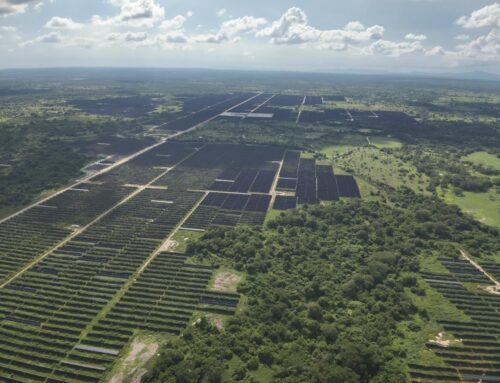Canada Tariff Fears: Does NY’s Clean Energy Push Offer Protection?
March 31, 2025
Have you ever seen the beauty of Niagara Falls up close, listened to its rushing water? Or strolled around Niagara Falls State Park? There’s even a Niagara Falls Underground Railroad Heritage Center. If so, you’ve been literally, or nearly, touching the Canadian border.
The uncertainty around the tariffs that President Trump has been threatening to impose on Canada and other countries this week are rippling through the states that have the strongest economic ties with Canada, like New York, the home of Niagara Falls and the fourth largest state in the U.S. by population. To prepare for the impact of these tariffs, New York Governor Kathy Hochul directed the state’s energy agencies and Homeland Security and Emergency Services to conduct a “thorough review of the federal energy tariffs and Canadian retaliation that have caused significant instability in capital markets and threaten to drive up electricity and heating costs, destabilize New York’s energy markets,” and increase costs for New Yorkers statewide.
After this review, including consulting with relevant industries and the New York Independent System Operator, which runs the state’s grid, they issued the following statement: “According to the agencies, cost increases will not be material in the near-term due to New York’s rigorous policing of energy reliability and significant investment into clean energy and transmission projects. However, the cost increases will be borne by households and businesses across New York and, over time, with added influence from tariffs on other sectors, New Yorkers could experience compounding cost impacts.”
The review also concluded that New York’s aggressive push toward renewable energy has insulated the state somewhat from the cost increases the tariffs and volatility could bring, at least in the short term. “According to the agencies, cost increases will not be material in the near-term due to New York’s rigorous policing of energy reliability and significant investment into clean energy and transmission projects. However, the cost increases will be borne by households and businesses across New York and, over time, with added influence from tariffs on other sectors, New Yorkers could experience compounding cost impacts.”
What are the investments in clean energy New York has been making that insulate it from this volatility?
Governor Hochul has committed the state to transition to “70% renewably sourced electricity by 2030 and a zero=emission electric grid by 2040.” The state’s renewable energy portfolio includes solar, wind, hydropower, advanced geothermal energy, nuclear energy, and hydrogen.
The agency planning and innovating the state’s complex energy systems and this ambitious energy transition is NYSERDA, or the New York State Energy Research and Development Authority, which is celebrating its 50th anniversary this year.
“We are the state’s energy planner, so we’re responsible for really looking at the longer term needs from a broad energy system perspective of the state and, and helping our state be prepared for those needs well into the future,” NYSERDA President and CEO Doreen Harris told me in an exclusive interview on Electric Ladies Podcast recently.
“We do execute a number of different programs across the state, really facilitating energy efficiency, renewable energy, innovation, all economic development related to all of those things across the state.” With an annual budget of “around $2 billion,” they plan not in months or years, but “over decades.”
Energy planning inherently requires managing uncertainty because of its long timeline and capital intensiveness, so they develop “multiple scenarios” to take into account “very significant variations in the potential futures,” including “the changing climate.”
What metrics do they use to plan and measure success?
Harris told me that, “cost is a major aspect of our planning,” both in terms of affordability and, “We need it to be as cost effective as possible. One of the things that’s particularly challenging about the topic of cost is that we need major investments in our energy systems, no matter what we do.” Every scenario reflects higher energy demands in the decades ahead.
They also consider the benefits, including “health benefits, economic benefits, reliability benefits, etcetera,” she said, which includes reducing greenhouse gas emissions.
“As a good engineer, I call it a multi-variable equation.”
Is the “linchpin” of New York’s future electricity reliability vulnerable because of the tariffs on (and from) Canada?
One of New York’s marquee projects that has been in the works for years, which Harris called, “the linchpin really to addressing that reliability need, is a very large transmission project that is under construction now moving hydroelectric power from Canada into New York City. It’s the called the Champlain Hudson Power Express Project.”
Sometimes called “CHIPPIE,” the $6 billion project is scheduled to enter service in 2026. It will transmit hydropower from dams owned by Hydro-Québec in Canada to New York at all hours.
“Once it enters service in the spring of 2026, CHPE will be the largest transmission line in the U.S. built entirely underwater and underground,” sources told Politico’s E&E News in 2023. Some are considering the project a model for other states.
Advice for other state leaders on managing this moment in the energy revolution?
As New York presses full-speed ahead with its energy transition, I asked Doreen Harris her advice for other state leaders in the current political, economic and climate change dynamics.
“In my 15 years here, I have been able to see what this transition really looks like in practice. And, I think the foundation of this is that we need to be solving for many variables at the same time,” Harris explained.
“There’s a lot of metrics of success that we are working toward. It isn’t just about greenhouse gas emissions or cost or reliability or, you know, benefits coming to our state. It’s all of those things at the same time. So what we really need are leaders who can be nimble, who are understanding the landscape that we’re working within.” And, added that it needs to be “private sector led, government enabled,” as now-former Energy Secretary Jennifer Granholm put it.
Listen to the full interview with NYSERDA President/CEO Doreen Harris on Electric Ladies Podcast here.
Search
RECENT PRESS RELEASES
Related Post



